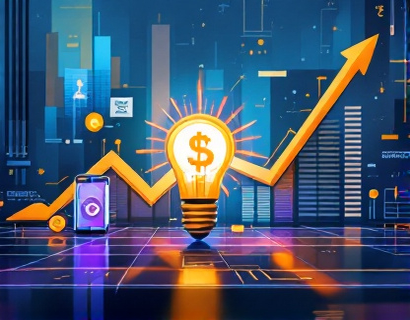Maximizing Strategic Growth: Leveraging Advanced Technology for Informed Decision-Making in Global Capital Analysis
In the rapidly evolving landscape of global capital markets, financial analysts and decision-makers face unprecedented challenges and opportunities. The integration of advanced technologies plays a pivotal role in navigating these complexities, enabling more informed and strategic decision-making. This article delves into the ways in which cutting-edge technologies can be leveraged to maximize strategic growth, providing comprehensive insights and actionable strategies for those involved in global capital analysis.
The foundation of any successful strategy in global capital markets is robust and timely data analysis. Traditional methods of data collection and analysis are often slow, prone to human error, and limited in scope. Advanced technologies such as artificial intelligence (AI), machine learning, and big data analytics offer transformative solutions to these challenges. These technologies can process vast amounts of data from diverse sources, identify patterns, and provide predictive insights that were previously unattainable.
Enhancing Data Collection and Processing
One of the most significant impacts of advanced technology in global capital analysis is the enhancement of data collection and processing capabilities. AI-driven tools can scrape data from multiple sources in real-time, including financial news, market reports, and social media. This real-time data collection ensures that analysts have access to the most current information, reducing the risk of making decisions based on outdated data.
Machine learning algorithms can further refine this data by filtering out noise and identifying relevant patterns. For instance, natural language processing (NLP) techniques can analyze textual data from news articles and reports to gauge market sentiment and identify potential risks or opportunities. This level of granularity and speed is crucial in a market where conditions can change rapidly.
Predictive Analytics and Risk Management
Predictive analytics is another area where advanced technology significantly enhances decision-making. By applying machine learning models to historical data, analysts can forecast future market trends with greater accuracy. These models can identify correlations and trends that human analysts might miss, providing a more comprehensive view of potential outcomes.
Risk management is a critical component of strategic growth in global capital markets. Advanced technologies enable more sophisticated risk assessment and mitigation strategies. For example, AI can simulate various market scenarios to evaluate the potential impact of different risks on a portfolio. This scenario analysis helps in developing robust risk management plans that can adapt to changing market conditions.
Automation and Efficiency
Automation is a game-changer in the realm of financial analysis. Repetitive and time-consuming tasks such as data entry, report generation, and basic analysis can be automated, freeing up analysts to focus on higher-value activities. Robotic process automation (RPA) and AI-driven workflows can streamline these processes, reducing errors and increasing efficiency.
Automation also extends to trading and execution. Algorithmic trading systems can execute trades based on predefined criteria, ensuring consistency and speed. These systems can operate 24/7, capitalizing on market opportunities that might be missed by human traders due to time constraints or fatigue.
Enhanced Collaboration and Communication
The integration of advanced technologies fosters better collaboration and communication among team members and stakeholders. Cloud-based platforms and collaborative tools enable real-time sharing of data and insights, breaking down silos and enhancing team productivity. Decision-makers can access the same up-to-date information, ensuring alignment and consistency in strategic decisions.
Moreover, advanced visualization tools can transform complex data into intuitive and actionable insights. Interactive dashboards and charts allow stakeholders to explore data from multiple angles, facilitating a deeper understanding of market dynamics and informing more strategic decisions.
Customized Insights and Personalization
Advanced technologies enable the creation of customized insights tailored to the specific needs of different stakeholders. Machine learning algorithms can analyze user behavior and preferences to deliver personalized recommendations and reports. This level of personalization ensures that each analyst or decision-maker receives the most relevant information, enhancing the effectiveness of their work.
For instance, a portfolio manager might receive tailored insights on asset allocation strategies based on their investment goals and risk tolerance. This personalized approach not only improves decision-making but also increases user satisfaction and adoption of analytical tools.
Challenges and Considerations
While the benefits of advanced technologies in global capital analysis are substantial, there are also challenges and considerations to keep in mind. Data privacy and security are paramount concerns, especially when dealing with sensitive financial information. Implementing robust security measures and adhering to regulatory standards is essential to protect data integrity and compliance.
Another challenge is the need for skilled professionals who can effectively leverage these technologies. Financial institutions must invest in training and development to ensure their teams have the necessary expertise to use advanced tools effectively. Additionally, the integration of new technologies requires careful planning and management to avoid disruptions and ensure seamless adoption.
Future Trends and Opportunities
The future of global capital analysis is increasingly intertwined with technological innovation. Emerging technologies such as blockchain, quantum computing, and the Internet of Things (IoT) are poised to further transform the landscape. Blockchain can enhance transparency and security in transactions, while quantum computing has the potential to solve complex optimization problems that are currently infeasible with traditional computing.
The IoT can provide real-time data from various sources, such as sensors and devices, offering new dimensions of insight into market dynamics. These technologies, when integrated with existing advanced analytics, can create a more comprehensive and dynamic decision-making framework.
Conclusion
In conclusion, leveraging advanced technologies is essential for maximizing strategic growth in global capital markets. By enhancing data collection and processing, improving predictive analytics and risk management, automating routine tasks, fostering collaboration, and providing customized insights, financial analysts and decision-makers can navigate the evolving financial landscape with greater confidence and precision. While challenges exist, the opportunities for innovation and improved performance are vast. Embracing these technologies is not just an advantage but a necessity in today's fast-paced and interconnected world.










































